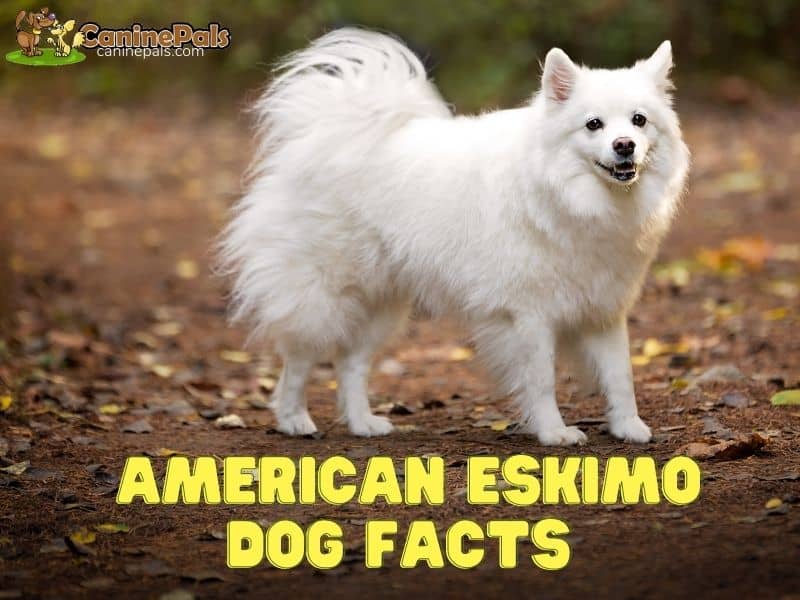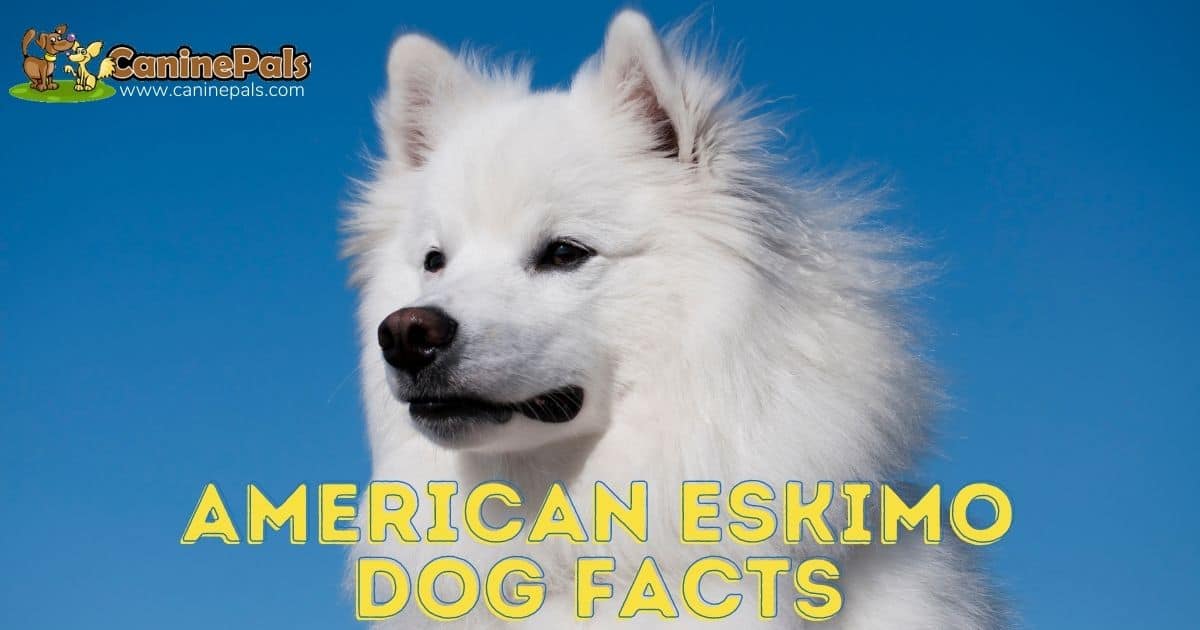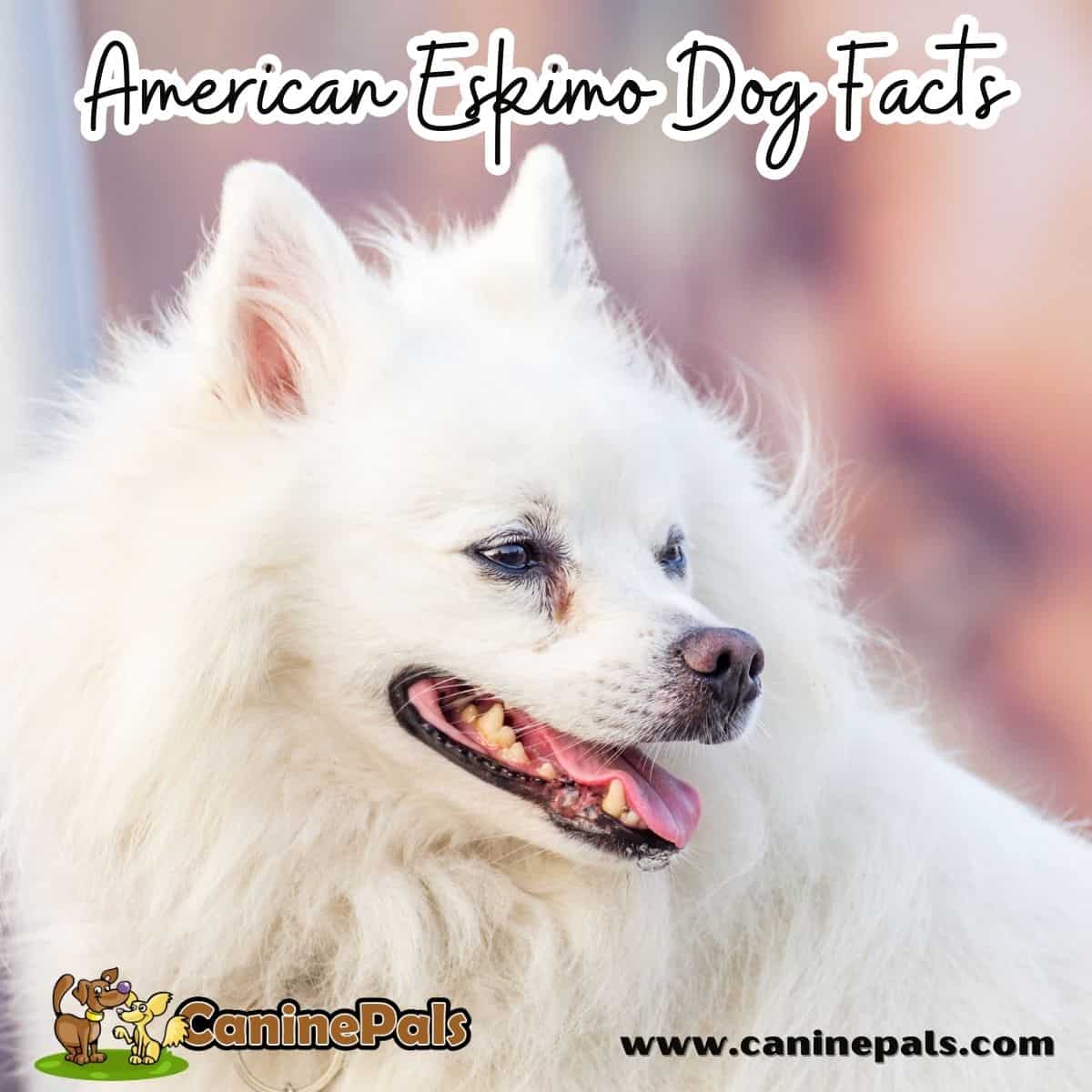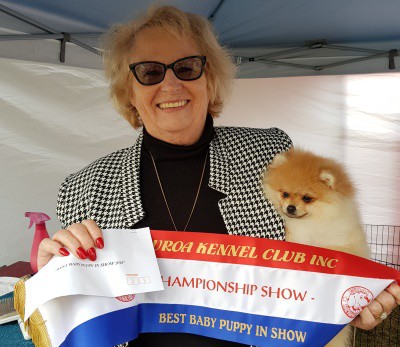Last Updated on March 20, 2024 by Denise Leo. Post first published on July 20, 2023.
Get the facts you need about the American Eskimo Dog breed at CaninePals.com! Learn practical tips, helpful advice, and fun facts about these beloved dogs.
An American Eskimo dog looks like an ultimate snow angel. With an Eskie (the American Eskimo’s nickname), a cuddle or two is enough to melt your heart. The poofy Eskimo takes no time winning your love. SURE!
Still, many dog lovers want to know some interesting American Eskimo dog facts and relish their uniqueness. Well, American Eskimo dog facts are what I plan to uncover in this blog post.
Let’s start the fun.

7 Lesser-Known American Eskimo Dog Facts
So, here we are with the most exciting facts that every Eskie owner should know. I bet you’ll be glad you know the fun facts about your dream dog.
Here we go!
1. They Own an Amazing Title
To celebrate and acknowledge the aesthetic beauty of the white Eskimo dog, their admirers rightly gave them an amazing title – “The dog beautiful”! What else could somebody call this snowy beauty, right?
2. Their Origins are in Germany
Oh, so when you first read the name the American Eskimo Dog, you thought Eskies originated in America?
But let me correct you…
The ancestors of the American Eskimo Dog originated in Germany and were the descendants of German Spitz.
3. Eskies were used as Herders and Guard dogs
Now everyone’s favorite family pets – American Eskies- were herders, livestock guards, and hunting dogs back then. No, they were never bred to be sled dogs, but they can surpass agility competitions.
4. The Secret Reason behind their Popularity
Do you know what made American Eskimos so popular? Their entertaining agility stunts! In the late 19th century, traveling circuses shot up the fame of the American Eskimo dogs. Eskies were easy to train and perform in the circus. Their snowy white coats made them sparkle in the spotlight and rock the circus. Thanks to their showy looks!
5. Eskie – the First Dog to Walk a Tightrope!
You might have seen acrobats walking a tightrope. Right? But…
How in this world can a dog walk on a tightrope? It’s unbelievable! However, an American Eskie, Pierre left its admirers in awe by becoming the first dog to walk a tightrope. Woah! Pierre was America’s most performing dog in the 1930s.
6. They have Three Distinct Sizes.
American Eskimos come in three sizes. Standard, miniature, and toy. And the standard size weighs no more than 35 lbs.
7. They Come in Delicious “Biscuit” Colors.
Eskies come in amazingly cute colors. They either come in complete white color or white with biscuit color. “White with biscuit color?” You might wonder.
That means an Eskie has a white coat and a “biscuit” colored fur around the corners.
A Glimpse into American Eskimo Dog History

In the early 1800s, when the German immigrants made their way to American shores, they left an ever-lasting Nordic impression in the upper Midwest.
They brought another incredible thing to America besides German-style food, culture, Lutheranism, and the brewing industry. You guessed that right; it was none other than – The nordic dog breed called German Spitz.
Later on, these little whiteys became the ascendants of modern Eskies. Here’s a detail of the breed’s working history.
On the Farms:
German Spitz were originally used as farm dogs. These farm dogs would keep the predators and strangers out of their territory there. Not only did these farm dogs have to recognize their dog breed, but they also had to differentiate between the invading livestock.
Arriving in the US:
When German settlers moved to the US, they resided in the Midwest, Southern Texas, and New England, which looked much similar to the German countryside. After settling in America, the Germans still used the ‘Spitz’ like they did in Germany.
Circus Life:
Spitz’s journey as the circus trick dog had begun in Germany since the breed was eye-catching, intelligent, and easily trained. The gypsies would teach their Spitz the tricks and invite the townspeople to watch. Subsequently, some of the circuses in Europe started using Spitz in their circus acts. In the late 19th century, the American Eskimo dog ruled the traveling circuses.
A little on its official club registration now…
In 1913, the United Kennel Club (UKC) registered the breed named “Spitz.” Spitz is a German word that means “Sharp point.” These dogs were named Spitz because when they would become alert, their ears would stand erect like a sharp point. Also, these Spitz breeds are called Nordic breeds. Both of these terms are interchangeable.
America took up World War I in 1917, and later this entry latched on to a severe prejudice against every Teutonic thing. In 1925, the breed’s German name – American Spitz – was changed to American Eskimo Spitz. Afterward, in 1926, the German word “Spitz” was completely removed from the name.
This is how we came up with the new name of Eskies – American Eskimo! This new name was chosen to honor a Kennel Club of the same name located in Ohio. 1995 was the year when finally the American Kennel Club (AKC) recognized the American Eskimo Dog as a breed. But they did not separate the breed into its further sizes and varieties.
Thus, we find Eskimos in the Non-sporting group of the American Kennel Club (AKC). And in the Nordic group of the United Kennel Club (UKC).
American Eskimo Dog Characteristics

American Eskimo dog is a charming, perky, and playful dog. Eskies are a combination of beauty and energy at the same time! Their unique physical traits include a fox-like face, triangular black nose, pricking ear, pearly eyes (not fully round, slightly oval), and black to dark brown eye rims.
What adds more to their beauty?
Their white coat and a plumed tail – which he proudly and loosely carries above his back! Though the Eskimos have a stand-off coat, it’s thick, glossy, smooth, and straight. Apart from that, you’ll also see a ruff from his chest to the shoulders. That lion-like ruff is more prominent in Eskie males than females.
Moreover, the American Eskies are dogs choked full of energy. Always ready to take up mental challenges and vent out through exercising. If you leave an Eskie alone for long periods or don’t provide him the required exercise level, he’ll become destructive.
The way out?
Keep your snow mutt engaged. You can do so by providing him with a collection of interactive toys in a securely fenced yard. Another wise choice is to keep him in his crate.
I hope that makes sense!
The Size of American Eskimo Dog:
American Eskimos are small to medium-sized dogs. And they come in three size variations. Here is a lowdown of their three sizes and weights.
- Standard – Height: 15 to 19 inches, Weight: 25 to 35 pounds
- Miniature – Height: 12 to 15 inches, Weight 10 to 20 pounds
- Toy – Height: 9 to 12 inches, Weight: 6 to 10 pounds
American Eskimo Dog Personality
American Eskimos are highly social dogs. They love being a part of a family and enjoy companionship. They are so keen to delight their owners. It looks like it were the Eskies who invented the term “eager to please.”They didn’t just come up with the term. They ACTUALLY mean it!
Don’t let their warm coat fool you. Eskies are indoor dogs happy to bond with the people around them. They love to interact. In their puppyhood, they are the most playful pups you’ll see. When they reach above their middle age, they become calm, which is another level of cuteness!
An Eskie craves nothing but companionship and interaction. If you leave your furry alone too often (which you shouldn’t) and don’t have a healthy interaction, I am afraid your cute boy will become problematic out of boredom.
You know what…?
To own an American Eskimo dog, you must be confident. Only a sure-footed leader can become an Eskie in charge and accompany him. Eskies are fast learners. They can even learn by observing other dogs. Therefore, training an American Eskimo dog can be a pleasant experience.
Are American Eskies Smart?
American Eskies are a complete package of brain and beauty! So, they are smart, for sure. They have the instinct to please. And due to their quick and curious nature, Eskies are said to be smart doggies. Eskies are among the most trainable breeds.
Teach them simple commands; they will master them. Train them for the most complicated tricks – like, walking a tightrope – they’ll get the hang of that too. Keeping their smartness in mind, the fact that American Eskies excelled at circus tricks is of little wonder.

How Much Do American Eskimo Dogs Shed?
American Eskimos have a double coat. The longer outer coat and a short, dense undercoat – below the outer coat! You’ll be surprised to know that despite their white coat color, Eskimos are extremely easy to keep clean. That’s so because their body produces oil that doesn’t let dirt cling to the fluffy’s fur.
However, American Eskimo dogs shed a lot. Almost constantly. You can thoroughly brush their fur to remove the dead hair before it spreads out. Brushing also will help detangle the fur. Above all, their fur’s upkeep is not a task you have to perform every day. Brushing only twice or thrice a week will suffice.
Do American Eskimo Dogs Smell?
Many dog owners are worried about that displeasing dog smell. But when considering an Eskie to be your companion, let this concern go aside. American Eskimos don’t smell unless they are VERY dirty. They love cold weather. However, they also fare well in other climates.
The Lifespan of American Eskimo Dogs
Another noteworthy thing American Eskimo Dogs are known for is their longevity. Many Eskies have lived until their middle to late teens. However, the average lifespan of an American Eskimo dog is 13 – 15 years.
Health Problems
American Eskimos are relatively a healthy breed as compared to other dog breeds. But, of course, they are not completely free of health concerns.
Hip Dysplasia:
Hip Dysplasia is an inherited condition. In this condition, the thigh bone doesn’t fit in the hip joint. As your dog ages, this disease can further open the doors for arthritis.
Progressive Retinal Atrophy (PRA):
In this disease, the retina of the dog’s eye starts deteriorating. First off, a dog becomes night-blind. As the disease progresses, they may also lose sight during the day.
Legg-Calve-Perthes Disease:
This desperate condition involves the dislocation of the hip joint. If your Eskimo dog has this condition, the blood supply to the head of the femur – the larger rear leg bone – is lessened. Hence, the head of the femur starts to lose unity with its main part. The symptoms of this condition are atrophy of the leg muscle and limping.
Juvenile Cataracts:
This eye disease is thought to be hereditary. You’ll find this health condition in normally younger Eskie pups under six years old!
The Average Price of an American Eskimo Pup
An American Eskimo pup’s range is between $700 and $1500. If we talk about the average price of a puppy less than six months of age it would be $1000.
Some factors that affect the ranges of Eskimo puppies are the following:
- A purebred or mixed
- Bloodline and breeder’s reputation
- Pedigree
- Medical expenses
- Training and Socialization expenses
- Popularity in the buyer’s location
- Age
- Coat color and markings
Quick American Eskimo Dogs Information and Facts
The American Eskimo Dog is a Nordic dog known for his white coat, black points (nose, lips, and rims of his eyes), and erect, triangular ears. He used to be a circus dog but today is mainly used as a companion and also participates in shows for agility, obedience, and conformity.
His double white coat has a dense, short undercoat that’s covered by longer hairs that protect his body and stand out from the body. His ancestors were the Keeshond, the German Spitz, the Italian Spitz, and the white Pomeranian.
This dog is alert, intelligent and friendly but also makes a great watchdog because he can fiercely protect his family and home. He’s a fast learner and keen to please.
He needs to exercise every day. As his coat sheds hair, it must be bathed and brushed regularly. The American Eskimo Dog has three types: standard, miniature, and toy. The sizes range down from 19 to 9 inches high from the shoulders.
Final Thoughts on American Eskimo Dog Characteristics:
The American Eskimo dogs are striking dogs with sweet expressions on their face. Love them, and they’ll love you back. Ask them to guard; they’ll do their duty.
Teach them some tricks, and they’ll stupefy you. Overall, this perky creature is enough to brighten your mood.
The best part?
Get an American Eskimo, and you won’t have to wait for the snow season to grab a snowball. Believe me; you’ll enjoy your Eskie more than the snow. Woo-hoo! I hope you enjoyed reading the American Eskimo dog facts. What was the most enticing fact you came to know? Tell me by dropping a quick comment below.
Have an Eskie-llent day!
Copyright CaninePals.Com. All Rights Reserved.
References and Further Reading:
[1] American Kennel Club, American Eskimo Dog Information.


